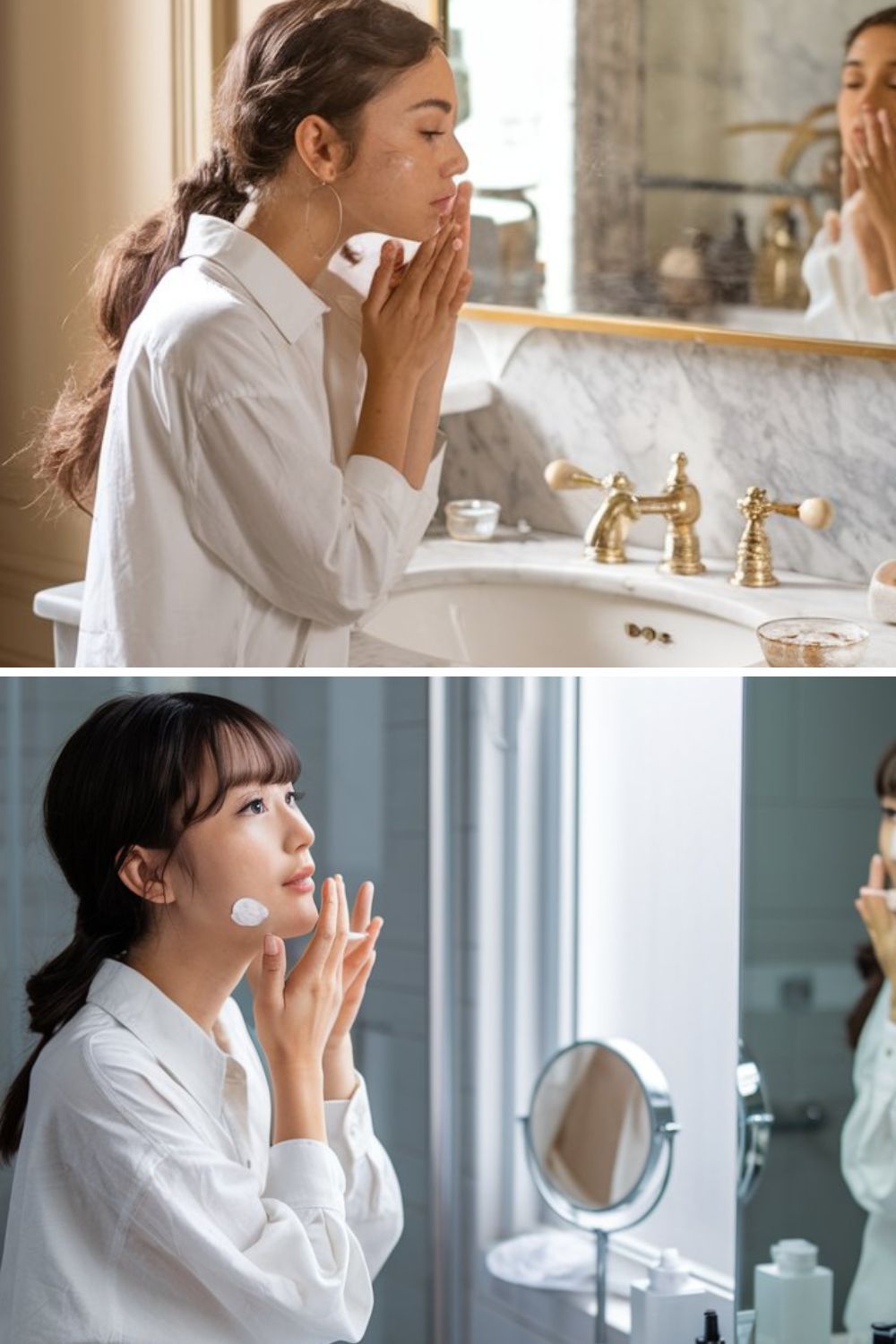There are two major players in the skincare industry: French and Japanese. These two countries have long been known for their innovative and effective skincare products, but each has its own unique approaches and philosophies when it comes to achieving beautiful, glowing skin.
So let’s explore the similarities, differences, and benefits of French and Japanese skincare.
When it comes to skincare, there are two countries that often stand out as leaders in the field: France and Japan. Both have a rich history and tradition of skincare practices, but what sets the two apart?
The history of skincare in both France and Japan dates back centuries. In France, skincare has long been a status symbol, with the elite classes using expensive and lavish products to maintain their youthful appearances. In fact, the first recorded face cream was created by a French physician in the 13th century. Since then, France has become synonymous with luxury skincare brands such as Chanel, Dior, and Lancôme.
In contrast, Japanese skincare has a more humble origin. Traditional Japanese medicine, known as Kampo, has been focused on natural remedies and treatments for centuries. Skincare was seen as an essential part of overall health and wellness. Japanese skincare brands, such as Shiseido, have a long history of using traditional ingredients like rice bran and green tea in their products.

Comparing the Two Countries’ Ingredients
Speaking of ingredients, this is where the biggest difference between French and Japanese skincare lies.
French skincare tends to focus on active ingredients, such as retinol, glycolic acid, and hyaluronic acid, all of which have been scientifically proven to improve the skin’s appearance. These ingredients can be quite harsh and may cause irritation, so products from France tend to be more suitable for those with oily or acne-prone skin.
On the other hand, Japanese skincare often leans towards natural and traditional ingredients, such as rice bran, sake, and green tea. These ingredients have soothing and nourishing properties and are believed to be gentle on the skin, making Japanese skincare products more suitable for those with dry or sensitive skin.
Skincare Philosophy in France vs. Japan
Another significant difference between French and Japanese skincare is their philosophy. French skincare focuses on targeting specific skin concerns, such as wrinkles, dark spots, and acne, with targeted products. In contrast, Japanese skincare follows a more holistic approach, focusing on the overall health and balance of the skin.
Japanese skincare also places a strong emphasis on prevention rather than just treating existing skin issues. This means incorporating practices such as double cleansing, exfoliation, and facial massage into the daily skincare routine to maintain healthy and glowing skin.
Japanese vs. French Skincare Products
Let’s take a closer look at the top skincare products in each country.
Japanese vs. French Face Cleansers
Both Japanese and French face cleansers have garnered a loyal following due to their unique formulations and approaches to skin health. While Japanese cleansers often emphasize gentle, hydrating ingredients, French cleansers are known for their effectiveness and simplicity.
Top 3 Japanese Face Cleansers:
Shiseido Senka Perfect Whip Cleansing Foam: This rich, foamy cleanser deeply cleanses the skin while maintaining moisture, leaving it soft and refreshed.
Shiseido Senka Perfect Whip Cleansing Foam 120g (Japan Import)
7% OffDHC Deep Cleansing Oil: A popular oil-based cleanser that effectively removes makeup and impurities without stripping the skin of its natural oils.
Hada Labo Tokyo Gentle Hydrating Cleanser: Infused with hyaluronic acid, this cleanser hydrates while cleansing, making it ideal for dry or sensitive skin types.
Top 3 French Face Cleansers:
Bioderma Sensibio H2O Micellar Water: This micellar water gently removes makeup and impurities while soothing sensitive skin, making it a favorite for quick cleansing.
La Roche-Posay Toleriane Purifying Foaming Cream: A gentle foaming cleanser that purifies the skin without causing irritation, perfect for normal to oily skin types.
Vichy Pureté Thermale Fresh Cleansing Gel: This gel cleanser combines thermal water and cleansing agents to remove impurities and refresh the skin, suitable for all skin types.
The choice between Japanese and French face cleansers largely depends on individual skin concerns. For those with dry or sensitive skin, Japanese cleansers like Hada Labo and DHC may provide the hydration and gentleness needed. Conversely, if you’re looking for effective makeup removal and a refreshing cleanse, French options like Bioderma and La Roche-Posay are excellent choices.
Japanese vs. French Face Creams
When it comes to face creams, both Japanese and French brands offer innovative formulations that cater to many skin types and concerns. Japanese face creams often focus on hydration and skin barrier protection, while French creams are renowned for their effectiveness and luxurious textures.
Top 3 Japanese Face Creams:
Shiseido Benefiance Wrinkle Smoothing Cream: This rich cream targets fine lines and wrinkles while providing deep hydration, making it ideal for mature skin.
Hada Labo Tokyo Skin Plumping Gel Cream: Infused with hyaluronic acid, this gel cream delivers intense moisture and plumps the skin, perfect for those with dry or dehydrated skin.
SK-II R.N.A. Power Radical New Age Cream: This anti-aging cream improves skin elasticity and firmness while providing a smooth, radiant finish.
Top 3 French Face Creams:
La Roche-Posay Toleriane Double Repair Face Moisturizer: A lightweight moisturizer that restores the skin’s natural barrier and provides long-lasting hydration, suitable for sensitive skin.
La Roche-Posay Toleriane Double Repair Moisturizer
$24.99 ($7.39 / fluid ounce) (as of December 23, 2025 21:22 GMT -05:00 - More infoProduct prices and availability are accurate as of the date/time indicated and are subject to change. Any price and availability information displayed on Amazon at the time of purchase will apply to the purchase of this product.)Vichy Aqualia Thermal Rich Cream: This cream combines thermal water and hydrating ingredients to provide intense moisture and soothe dry skin, making it ideal for those in need of hydration.
Caudalie Vinosource Moisturizing Sorbet: A gel-cream that calms and hydrates the skin, perfect for sensitive or reactive skin types.
The best choice between Japanese and French face creams depends on your specific skin concerns. For those seeking deep hydration and anti-aging benefits, Japanese creams like Hada Labo and SK-II are excellent options. On the other hand, if you have sensitive or reactive skin, French creams such as La Roche-Posay and Caudalie may provide the soothing and restorative properties you need.
Japanese vs. French Serums
Both Japanese and French brands offer potent formulations designed to target specific skin concerns and enhance overall skin health. Japanese serums often emphasize hydration and skin barrier support, while French serums are known for their effectiveness and luxurious textures.
Top 3 Japanese Serums:
SK-II Facial Treatment Essence: This iconic essence is packed with Pitera, a natural ingredient that promotes cell renewal, resulting in improved skin texture and radiance.
Hada Labo Tokyo Anti-Aging Hydrator: Infused with multiple types of hyaluronic acid, this serum provides intense hydration and helps to plump the skin, making it ideal for dry or aging skin.
Shiseido Ultimune Power Infusing Concentrate: This serum boosts the skin’s natural defenses, enhancing its resilience and overall appearance while providing hydration and radiance.
Top 3 French Serums:
Vichy Mineral 89 Hyaluronic Acid Serum: A lightweight serum that combines mineral-rich thermal water and hyaluronic acid to hydrate and strengthen the skin’s barrier, suitable for all skin types.
Caudalie Vinoperfect Radiance Serum: This brightening serum targets dark spots and uneven skin tone, promoting a more luminous complexion with its natural viniferine ingredient.
La Roche-Posay Hyalu B5 Serum: Formulated with hyaluronic acid and vitamin B5, this serum hydrates and repairs the skin, making it ideal for sensitive or dehydrated skin.
For hydration and anti-aging benefits, Japanese serums like Hada Labo and SK-II are excellent options. Conversely, if you are targeting issues like dark spots or sensitivity, French serums such as Caudalie and La Roche-Posay may be more suitable.
French vs. Japanese Body Lotions
When shopping for body lotions, both Japanese and French brands sell unique formulations for a multitude of skin types and hydration needs. Japanese body lotions often focus on lightweight textures and deep hydration, while French lotions are known for their nourishing properties and luxurious feel.
Top 3 Japanese Body Lotions:
Hada Labo Tokyo Skin Plumping Gel Lotion: This gel lotion is infused with hyaluronic acid, providing intense hydration and leaving the skin feeling plump and refreshed without a greasy residue.
Shiseido Senka Perfect Whip Body Lotion: A lightweight lotion that absorbs quickly, it hydrates the skin while maintaining a soft and smooth texture, perfect for daily use.
Nivea Japan Moisture Body Lotion: This lotion combines deep moisture with a light texture, making it ideal for dry skin while providing a refreshing feel.
Top 3 French Body Lotions:
Bioderma Atoderm Intensive Baume: A thick, nourishing balm designed for very dry skin, it provides long-lasting hydration and helps restore the skin barrier, making it ideal for sensitive skin.
Bioderma Atoderm Intensive Balm Ultra-Nourishing Body Cream for Dry Skin, 16.9 Fl Oz
25% OffL’Occitane Almond Milk Concentrate: This rich lotion nourishes and softens the skin with almond milk and almond oil, leaving a silky finish and a delightful scent.
Caudalie Vinosource Moisturizing Sorbet: A lightweight, soothing lotion that hydrates and calms the skin, perfect for those with sensitive or reactive skin types.
For lightweight hydration and a refreshing feel, Japanese lotions like Hada Labo and Shiseido are excellent options. On the other hand, if you have very dry or sensitive skin, French lotions such as Bioderma and L’Occitane may provide the rich nourishment and soothing properties you require.
French vs. Japanese Skincare for Anti-Aging
When it comes to anti-aging skincare, both Japanese and French brands offer innovative products that target signs of aging and promote youthful skin. Japanese anti-aging products often emphasize hydration and skin barrier support, while French products are known for their effectiveness and luxurious formulations.
Top 3 Japanese Anti-Aging Products:
Shiseido Benefiance Wrinkle Smoothing Cream: This rich cream targets fine lines and wrinkles while providing deep hydration, making it ideal for mature skin.
SK-II R.N.A. Power Radical New Age Cream: This powerful cream improves skin elasticity and firmness, helping to reduce the appearance of wrinkles and promote a more youthful complexion.
Hada Labo Tokyo Age Correcting Serum: Infused with multiple types of hyaluronic acid, this serum provides intense hydration and plumps the skin, effectively addressing signs of aging.
Top 3 French Anti-Aging Products:
Vichy Liftactiv Supreme Anti-Aging Cream: This cream combines powerful anti-aging ingredients with Vichy mineral water to visibly reduce wrinkles and improve skin firmness, suitable for all skin types.
Caudalie Resveratrol Lift Firming Serum: A lightweight serum that harnesses the power of resveratrol to boost collagen production and improve skin elasticity, targeting sagging and fine lines.
La Roche-Posay Redermic R Anti-Aging Retinol Cream: This retinol-infused cream helps to reduce the appearance of wrinkles and uneven skin tone while being gentle enough for sensitive skin.
The choice between Japanese and French anti-aging skincare largely depends on your specific skin concerns. For deep hydration and a focus on skin barrier support, Japanese products like Shiseido and Hada Labo are excellent options. Conversely, if you want effective anti-aging solutions that target wrinkles and firmness, French products such as Vichy and Caudalie may be more suitable.
Japanese vs. French Skincare Pricing
It’s no secret that French skincare can be expensive, with many luxury brands commanding high price tags. This is due to the aggressive marketing of France as a “luxury” destination and also the use of high-quality, active ingredients in their products. On the other hand, Japanese skincare tends to be more affordable, with many brands offering effective products at a lower price point.
Final Thoughts
In the end, both French and Japanese skincare have their own unique qualities and benefits. While the French approach may be more targeted and results-driven, Japanese skincare focuses on natural and holistic remedies. Which one is right for you ultimately depends on your skin type, concerns, and budget.
However, I would recommend combining the best of both worlds. Incorporate active ingredients from French skincare and traditional ingredients from Japanese skincare to achieve healthy and balanced skin. And always remember that no matter where your skincare products come from, consistency and proper usage are key to achieving desired results. So, don’t skip out on your daily routine and follow it diligently for the best results.













